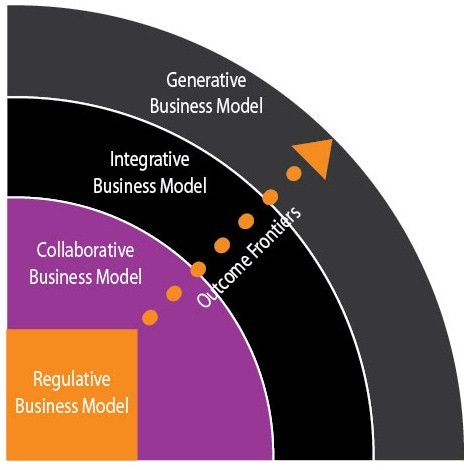
As a human services organization progresses to a “Collaborative Business Model,” the focus expands beyond program “silos” and categorical management to support individuals and families in receiving the best mix of services for which they are eligible and in helping them address immediate needs. In this level the vision and mindset of the organization is on learning and adopting new collaborative competencies that can mature and scale for the future. In action, entities collaborate on some policy and programs and may have some common information and referral, intake, eligibility, and team-based case planning. The technologies and tools adopted facilitate limited cross-organization information sharing and decision-making.
Diagnostic Metrics & Checkpoints:
- Outcomes & Impact Design: The enterprise is shifting from silo-based output reporting to the measurement of outcomes by collecting information and metrics deeper within organizations and across programs.
- Organizational & Practice Design: The enterprise is working towards a customer-centric organizational model by sharing case information, coordinating services across programs and organizations, and shaping client-friendly solutions.
- Systems & Technology Design: The enterprise is implementing an integrated, single-view system for case management across programs and organizations and enabling service collaboration and outcome tracking by customer and by aggregate.
Take for example the move to Collaborative Business Models in Michigan, Massachusetts, and Australia.
In Michigan, collaboration across sectors came to the fore as the State of Michigan and non-profit service provider Matrix Human Services partnered on holistic services and launched “Transition to Success” in 131 state schools. The system of care merged already-funded services focused on breaking generational poverty into research-based interventions: comprehensive case management, volunteerism, life coaching, and financial literacy. Matrix helps clients map and execute their futures, and provides a curriculum for faith-based, education, and government agencies. As a result, client household income soared, and the program is a cornerstone of the governor’s plan to integrate public programs, private partners, and informal networks to deliver services in client neighborhoods.
In Massachusetts, officials created a new platform to measure outcomes across state agencies and programs in order to find areas for improved efficiency and effectiveness. The program, called “EHSResults” collects data and metrics for every state-run human services program. Agency heads together evaluate and retool functions and work across agencies to improve system-wide outcomes. Citizens like that results are online, and agency staff appreciate the easy-to-access metrics to self-assess performance. The resulting collaborative mindset has established a foundation for cross-agency innovation and solutions that are citizen-centric.
The Australia Department of Human Services is embracing a Collaborative Business Model to address many of the same challenges that governments around the world are grappling with, including changing demographics, long-term economic shifts, and a demand for more effectiveness and efficiency from human services investments. Australia is responding to these issues by tightly aligning their outcomes goals with cross-program collaboration and automating several systems and processes. For example, by connecting their Medicare system with Centrelink (assessment-based services), the country has been able to save more than $700 million over three years while improving access to services for citizens.